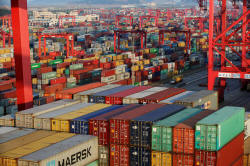|
Disappointing China trade
data spurs fears recovery may be faltering
 Send a link to a friend
Send a link to a friend
 [October 13, 2016]
By Yawen Chen and Kevin Yao [October 13, 2016]
By Yawen Chen and Kevin Yao
BEIJING
(Reuters) - China's September exports fell 10 percent from a year
earlier, far worse than expected, while imports unexpectedly shrank
after picking up in August, suggesting signs of steadying in the world's
second-largest economy may be short-lived.
The disappointing trade figures pointed to weaker demand both at home
and aboard, and deepened concerns over the latest depreciation in
China's yuan currency <CNY=CFXS>, which hit a fresh six-year low against
a firming U.S. dollar on Thursday.
"This comes on the heels of weak South Korean trade data, and it
definitely make us worry about to what extent global demand is
improving," said Luis Kujis, head of Asia economics at Oxford Economics
in Hong Kong.
Asian stocks tumbled to three-week lows and U.S. stock futures and
Treasury yields fell after the data, while copper prices in London
slipped. [MKTS/GLOB]
China's exports had been expected to fall 3 percent, slightly worse than
in August, as global demand for Asian goods remains stubbornly weak
despite heading into what is usually the peak year-end shopping season.

Weaker demand for Chinese goods was seen in nearly all of its major
markets in the U.S., Europe and much of Asia.
Imports shrank 1.9 percent, dashing hopes for a second rise in a row.
Imports had unexpectedly grown 1.5 percent in August, the first
expansion in nearly two years, on stronger demand for coal and
commodities such as iron ore which are feeding a construction boom.
That left China with a trade surplus of $41.99 billion for the month,
the lowest in six months, the General Administration of Customs said on
Thursday. Analysts had expected it to expand slightly to $53 billion.
The weaker trade readings could raise concerns about the other September
data and third-quarter GDP over the coming week. Economists had expected
that data to show the economy was stabilizing and perhaps even slowly
picking up.
The import reversal raises questions over the strength of the recent
recovery in domestic demand, Julian Evans-Pritchard at Capital Economics
said in a note.
"This could be an early sign that the recent recovery in economic
activity is losing momentum, although we would caution against reading
too much into a single data point given the volatility of the trade
figures," he said.
"The continued underwhelming performance of Chinese exports adds weight
to our view that the People’s Bank will maintain its recent policy of
gradual trade-weighted renminbi (yuan) depreciation in coming quarters,"
he added.
Last month, the World Trade Organization cut its forecast for global
trade growth this year by more than a third to 1.7 percent, reflecting a
slowdown in China and falling levels of imports into the United States.
"Sluggish external demand will continue to weigh on China's trade
outlook, given downside risks stemming from the U.S. election to the
UK’s execution of the Brexit process. We do not foresee exports being a
growth driver of the Chinese economy over the next few quarters," ANZ
economists said in a note.
[to top of second column] |

Container boxes are seen at the Yangshan Deep Water Port, part of
the Shanghai Free Trade Zone, in Shanghai, China September 24, 2016.
REUTERS/Aly Song/File Photo

Not
even a sharp increase in China's Apple iPhone shipments could offset the
broad-based downturn in September, ANZ added.
DOUBTS ABOUT RECOVERY
To be sure, China's imports of crude oil rose 18 percent on-year to a daily
record, while iron ore purchases surged to the second highest on record,
suggesting its demand for global commodities is hardly falling off a cliff.
Steel mills, in particular, appear to be running hot to meet demand from a
housing boom and government infrastructure projects, which are driving higher
profits though complicating government efforts to cut excess capacity.
But copper, coal and soybean imports all fell from August.
"China imported too much copper in the beginning of this year," said Chris Wu,
an analyst at CRU Beijing, a metals consulting firm. "The lagging effect from
the property market is still helping with some of the end use sectors for
example wire and cables and white goods, but we are afraid the boom is close to
the end."
A
Customs spokesperson said on Thursday rising imports of oil and other
commodities showed demand is improving, adding that the government's trade
policies is having positive effects.

After a rough start to the year, China's economy has shown signs of steadying
thanks largely to the building boom, but some analysts warn the housing frenzy
may be peaking as more cities impose restrictions on home buying to keep prices
from overheating.
Data have also highlighted increasing imbalances in China's economy, with growth
increasingly reliant on government spending as private investment falls to
record lows. Larger state firms are expanding, likely thanks to Beijing's
largesse, but smaller manufacturers continue to struggle.
(Reporting by Yawen Chen and Kevin Yao; Editing by Kim Coghill)
[© 2016 Thomson Reuters. All rights
reserved.] Copyright 2016 Reuters. All rights reserved. This material may not be published,
broadcast, rewritten or redistributed. |